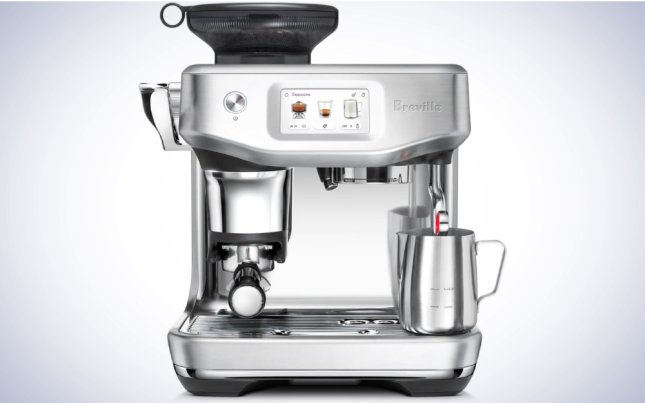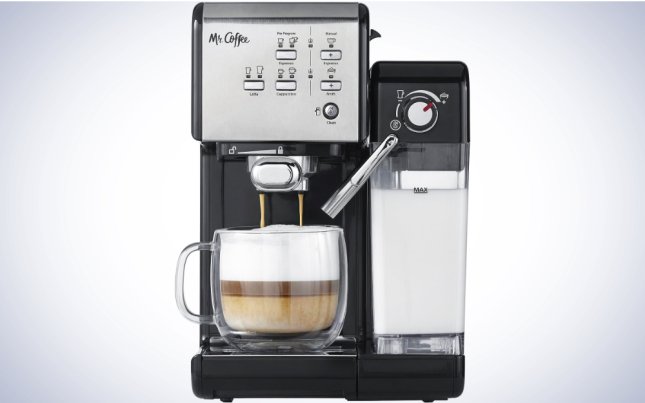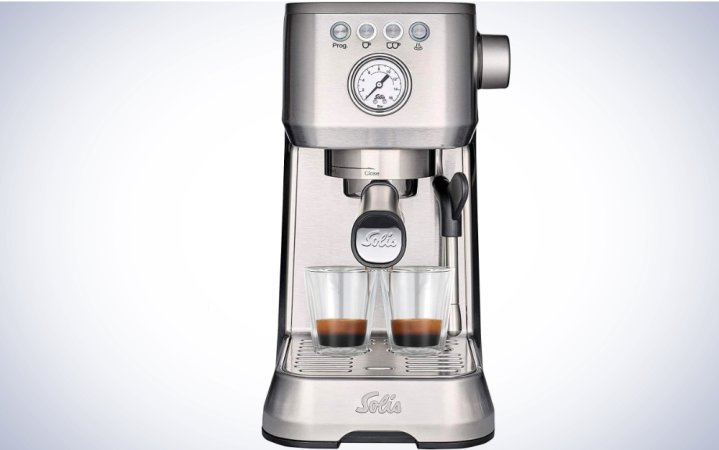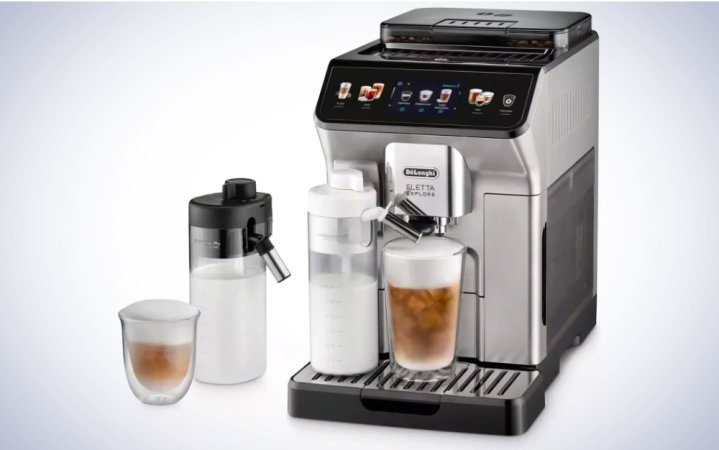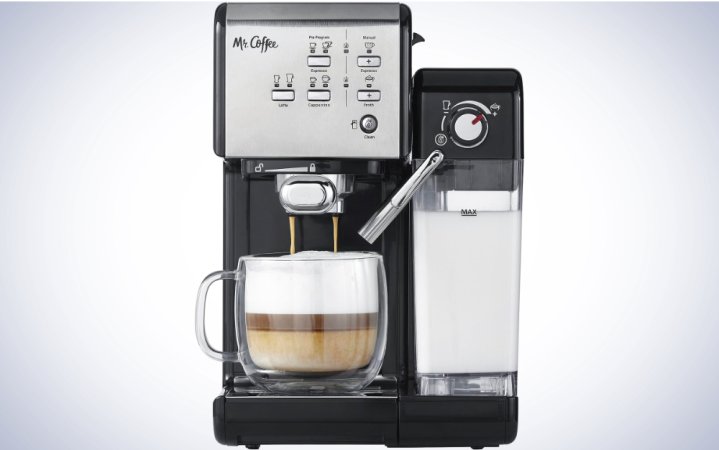We may earn revenue from the products available on this page and participate in affiliate programs. Learn more ›

Pumpkin spice love or hate aside, many of us tuck into lattes (and run to our latte machines) in the colder months for what can only be described as the coziest version of caffeine. It’s a security blanket for the soul, hygge we can cradle in our hands. Recreating a barista-quality latte macchiato or vanilla latte at home can be done, but it can be a challenge to get it just right. Latte machines come in a wide variety of styles, ranging from automatic wonders to maximal stainless-steel altars of dials, tubes, and built-in grinders to determine. Some require only the ability to select from a menu, while others need practice and patience. We’ve filtered through dozens of brands to find the best latte machines for anyone considering upgrading their at-home coffee options.
- Best overall: Breville Barista Touch Impress Espresso Machine with Grinder
- Best compact: Solis Barista Perfetta Plus Espresso Machine
- Best Nespresso machine for lattes: Nespresso Gran Lattissima Original Espresso Machine by De’Longhi
- Best for iced drinks: De’Longhi Eletta Explore Fully Automatic Coffee Machine
- Best splurge: Jura Z10 Aluminum White
- Best budget: Mr. Coffee Espresso and Cappuccino Machine
How we chose the best latte machines
For this roundup, we put our longtime caffeine addictions to good use, pulling from our collective experience, hands-on use, and expert and customer opinions to make recommendations. There’s a learning curve to making a great latte, and you don’t need a dedicated machine. You can pair one of PopSci’s picks for best espresso machines (or a Moka pot) with recommended milk frothers for a manual experience. For this roundup, however, we focused on machines with milk-based drink capabilities built-in that often do most of the work for you.
The best latte machines: Reviews & Recommendations
A latte sounds simple enough to make. It’s just espresso and some steamed milk … at least, in theory. In practice, there are the proportions of espresso to milk, how foamy the milk is, whether it’s enhanced with additional syrups or spices, and all sorts of customizations that transform this versatile indulgence into your latte. The more a drink is explicitly tailored to your tastes, the more experimentation it takes—and that’s without mentioning latte art yet. But, like in any laboratory, a successful experiment requires the right equipment for the job, and that’s what we’ve got here.
Best overall: Breville Barista Touch Impress Espresso Machine with Grinder
Specs
- Dimensions: 12.9 inches D x 13 inches W x 16.4 inches T
- Weight: 22 pounds
- Capacity: 67.6-ounce water tank capacity
Pros
- Step-by-step guidance
- Assisted tamping
- Built-in grinder
- Alternative milk settings
- 3-second heat
- Saves up to 8 customized drinks
- Comes in four colors
Cons
- Pricey
- Significant counter space required
- Hard to tell when water or beans are running out
Sometimes, when you’re learning, you need someone’s hand to hold during each step of a new process. That’s what Breville Barista Touch Impress Espresso Machine with Grinder does and why it’s our pick for the best overall at-home latte machine. It’s an excellent match for someone who loves espresso but has been intimidated by the thought of pulling their own shots (I’m looking at you, me).
A touchscreen walks you through every step of every drink on its menu. For example, select a latte, and the built-in burr grinder will portion grinds directly into the portafilter. You hit the lever for the built-in 22 lbs. tamper, and the Impress Puck System examines the result. Via the screen, it may prompt for more grinds or ask you to remove some. When you get a green check, you move the portafilter to the brew head, and the machine takes over. The Touch Impress includes a frothing wand and milk jug, and the “MilQ” system has presets for handling different types of milk, including almond and oat milk. However, the machine does not help you with how much or how to pour—that’s what you’ll have to figure out on your own. The jug includes minimum and maximum markers, but anyone making a traditional macchiato will toss out unused milk.
The allure of this semi-automatic machine is that it makes you feel like you’re doing more than you are, beeping corrections when the portafilter isn’t quite full or needs to be tamped again while still making some tasty espresso. It’s also a remarkably clean system. Anyone who’s dealt with a traditional machine or pouring freshly ground beans from a grinder knows how that dust gets everywhere and is magically staticy, but that is not the case here. There are a few downsides, including the roughly $1,500 price tag. And it’s hard to tell when beans or water is about to run out, and only a standard mug or shorter fits under the brew head. That’s not uncommon, however, which is why pictures of espresso machines usually feature shot glasses instead of travel mugs.
Best compact: Solis Barista Perfetta Plus Espresso Machine
Specs
- Dimensions: 17 inches D by 7 inches W by 12.5 H
- Weight: 18 pounds
- Capacity: 67.5 ounces
Pros
- Small footprint
- Heavy-duty tamper
- Multiple baskets for portafilter
- Temperature control
- Programmable shot volume
- Multiple color options
Cons
- Need a separate grinder
- No guidance
When counter space is at a premium, consider the semi-automatic Solis Barista Perfetta Plus Espresso Machine, which is a comparatively compact six inches wide. The machine is aimed at beginners who want to customize their espresso drinks, but you have to do the work.
The simple interface looks like only four buttons—and it is—but you can program the volumes of single and double shots, as well as the brewing temperature. Other subtle features put the Perfetta Plus above other similarly sized machines, like PID temperature control, low-pressure pre-infusion, a steam wand that rotates 360 degrees, hot water for tea or an Americano, and a cup-warming tray. It heats up in under a minute and has a programmable auto-shutoff.
Especially for a machine that’s just over $300, the Perfetta Plus accessories well. It comes with single and double wall filters for the portafilter, a stainless steel milk jug, a measuring cup, and shockingly sturdy tamper rather than flimsy plastic versions other makers include. The manometer (aka the dial on the machine) displays the extraction pressure of each shot. You’re aiming for about 9 bars of pressure, and this little dial can help you diagnose drinks that don’t turn out quite right. However, that’s going to take trial and error. This machine doesn’t follow recipes or have a screen for guidance. You’ll also need a separate grinder unless you opt for pre-ground beans or E.S.E. pods.
Best Nespresso machine for lattes: Nespresso Gran Lattissima Original Espresso Machine by De’Longhi
Nespresso Gran Lattissima Original Espresso Machine with Milk Frother
Specs
- Dimensions: 8 inches D x 14.4 inches W x 10.8 inches T
- Weight: 11.4 pounds
- Capacity: 34-ounce water tank capacity
Pros
- One-touch milk-based drinks
- Adjustable foam levels
- Additional platform for smaller cups
- Removable parts are dishwasher-safe
Cons
- Noisy operation
- All-plastic body
- Limited customization
The Nespresso Gran Lattissima Original Espresso Machine by De’Longhi embraces speed and nearly one-touch pick-me-ups. The best Nespresso machines work well for people who want robust coffee, prefer to avoid the fuss of grinding beans or foaming with a milk wand, and are content to have a machine do most of the work. You must, however, be comfortable buying coffee by the capsule.
At shy of $700, the plastic body is a little disappointing, but it comes in chic monochrome white or black. Like most Nespresso machines, it roars as it brews. The device prompts users through clean-up steps, pushing water through the tubes and connections to prevent build-up, but the sequence takes a little practice.
Is Nespresso espresso? Going by espresso’s water temperature and pressure specs, no. However, it hits the spot for many a latte lover, and it’s hard to beat the ease of use. It stands in a smaller footprint than most other options on this list.
Best for iced drinks: De’Longhi Eletta Explore Fully Automatic Coffee Machine
Specs
- Dimensions: 17.5 inches D by 10.5 inches W and 15.1 inches T
- Weight: 24.7 pounds
- Capacity: 60 ounces
Pros
- Highly automated
- Makes more than 40 drinks
- Built-in grinder with 13 settings
- Four user profiles for one-touch personalized coffee
- Brews 8-, 12-, and 16-ounce drinks
- Can fit travel mugs
Cons
- Large footprint
- Mostly plastic body
The De’Longhi Eletta Explore Fully Automatic Coffee Machine can make more than 40 different coffee drinks with minimal user effort and is our pick for the best for iced drinks. The colorful touchscreen features a menu of drinks grouped by cold, hot, or to-go, and it walks you through every step, right down to how many ice cubes to put in a cup. For iced drink lovers, what could be better? It does a lot, but it also costs a lot, at about $1,800.
The built-in conical grinder must be adjusted when you change beans, which some users report takes practice to get right, depending on what drinks you make the most. One difference from other latte makers—two things, actually—is that the Eletta Explore comes with two different milk carafes for producing hot and cold foam. Both carafes detach so they can be stored in the fridge when not in use, and the machine has a cleaning cycle to be performed after each milk-based beverage is made.
Another feature that is rare on espresso makers is a removable tray that allows a reasonable-sized (16-ounce, not a mega Stanley) travel mug to fit beneath the brew head.
Best splurge: Jura Z10 Aluminum White
Specs
- Dimensions: 17. 7 inches D by 12.6 inches W by 14.9 inches
- Weight: 27 pounds
- Capacity: 81 ounces
Pros
- Highly automated
- Built-in grinder with automatic tuning
- Makes more than 30 drinks
- App-compatible
- Adjustable dual spouts
Cons
- Expensive
- Huge footprint
- No milk container included
If price is no object, the Jura Z10 may be the super-automatic of your dreams. The Swiss-designed machine costs about $3,600, depending on color, and features designer touches like a blue-lit water reservoir and golden lighting at the spouts. The maker has a cult following for its flavor, design elements, and advances in brewing.
This massive machine makes more than 38 drinks with little user involvement, though you can dive into customizations, including temperatures and the fluffiness of foam. Select from the 4-inch color touchscreen or connect to the Jura Operating Experience app. (Get it? J.O.E.) The built-in grinder adjusts the coarseness according to the drink being made. This step can take considerable trial and error when done manually. The Z10 also boasts multiple cold-brew drinks, like cold brew cortados and cold brew flat whites. We’ve never heard of these before, but Jura’s cold brew recipes skip the heating element and push pressurized water through grinds.
The brew is finished in minutes, not the hours and hours of a traditional cold brew method. One serious kick in the pants is that the Z10 doesn’t include a milk container. It does have a tube, which you could, if you want, connect to the Z10 and drop it in a gallon of milk. This is either super annoying or secretly brilliant that you don’t have to clean another container—but that might depend on what mood you’re in. There are, of course, optional accessories like a branded glass container or a milk cooler.
Best budget: Mr. Coffee Espresso and Cappuccino Machine
Specs
- Dimensions: 10.6 inches D x 13 inches W x 14.3 inches T
- Weight: 14.2 pounds
- Capacity: 22-ounce water tank capacity
Pros
- Simple button interface
- Can do single or double shot-based drinks
- Removable, automatic milk frother
Cons
- Minimal control for milk texture
- Milk carafe has multiple components to clean
At about $225 and frequently on sale, the Mr. Coffee Espresso and Cappuccino Machine offers an affordable, simple machine with one-button operation and the flexibility to use whatever beans you choose.
With no grinder built-in, you need to fill the portofilter with the included measuring scoop and tamper. Lock in the portafilter, line up the milk carafe’s spout, and pick whether you want a one- or two-shot latte or cappuccino. Mr. Coffee handles portioning the milk—it will manage any milk, but no unique settings. When the drink is complete, run the “clean” function that pushes steam through the milk carafe connections and pop it back into the fridge. Users also note that the frothed tends to be loud, but that’s the case with many of this style machine.
What to consider when deciding between the best latte machines
Latte machines wildly vary in how much skill and coffee know-how they take to use. If your main focus is to have an appliance do the work, consider an automatic, semi-automatic, or capsule machine. Fully or super-automatic machines could be described as a barista in a box. They follow preprogrammed recipes and often have a milk carafe or hopper for hands-off steaming. They handle grinding the beans of your choice, measuring them, tamping them, brewing them, and measuring the milk for you, too. These machines zero in on producing a consistent drink repeatedly regardless of the user’s coffee knowledge.
Like making sourdough bread, lattes can be a hobby. Sometimes, you want to hone a craft even when it’s simpler and easier to buy the end product. Suppose you want to make The Perfect Latte. Consider a semi-automatic machine for maximum control. These machines require you to pack a portafilter with finely ground beans and tamp them to perfect flatness. The device controls water flow and usually has a wand for steaming milk. You handle portioning, pouring, and, if you have the skills, the foam art. These machines also take skill—or at least the willingness to troubleshoot if a drink misses the mark. Is it old beans? Is the grind too fine? Too coarse? Is the flow slow because the tamping isn’t right? Decide whether this sounds like an enjoyable puzzle to solve or a pain.
Capsule machines hit the spot for folks who don’t want to mess with beans. Drop a premeasured, preground pod, and the machine does most of the work for you. Most capsule systems feature automated milk carafes, but some have wands to allow more control.
Price
We’ve all likely heard skipping our daily lattes will lead us to financial freedom. It’s terrible advice, but lattes aren’t a cheap habit whether you’re dropping by a local shop or picking out a machine for home. Prices range wildly from $100 to easily $1,500. Models from prestige brands can be thousands. Many automatic latte machines include built-in grinders, tampers, and frothers, but buying all these coffee devices in one appliance doesn’t necessarily translate into paying less overall. A large part of what you’re paying for is the automation and not having to remember recipes yourself. Pick the price point that makes sense for your budget, and prioritize the features in that range.
Budget models often last three to five years, while higher-end models can last 12 to 15, according to commercial coffee supplier Majestic Coffee. I scored a deal on a Nespresso Lattissma Pro Espresso Machine about seven years ago, and it still works as well as the day I unpacked it, despite using it most days. (Note: I descale it whenever it tells me to.)
Milk matters
What’s the difference between an espresso machine and a latte machine? A square is a rectangle, but a rectangle is not a square. An espresso machine can make lattes but doesn’t necessarily have a milk-steaming component. A latte machine does. Because latte machines require espresso, they also often make black versions of espresso drinks (think lungos and ristrettos).
Selecting a latte machine with a carafe or hopper takes the guesswork out of coffee-to-milk ratios by following the programmed recipes. They froth milk to set times and consistency and then shoot it into the finished beverage. The only control a user has is usually twisting a dial for denser or fluffier foam.
Other models feature wands to use with a stainless steel milk jug. Some have wand controls to adjust texture and temperatures, while others follow a set program. A steam wand is the way to go when you want to pour the milk and foam yourself.
All milk doesn’t froth the same, whether you’re talking about whole or skim cow milk or alternatives like almond or oat. Some machines come with settings to indicate what type of milk needs foaming and adjust settings accordingly. Manual options will take experimentation.
Size
Dream of a beverage station stocked with fresh beans, carefully curated mugs, dainty little spoons, and all the assorted coffee accessories needed to start an at-home cafe? A latte machine is likely to be the centerpiece of such a station. In other words, they are big, steady fixtures, not something that gets put away after use to get back your counter. Consider how much space you’re willing to dedicate and look at how much space you have beneath upper shelves or cabinets, particularly if you’re scoping out models with a built-in grinder. They’re tall, and you need room to maneuver, whether refilling the beans or the water tank.
For a smaller space, skip the various built-ins, particularly if you have already snagged one of our picks for best coffee grinders.
FAQs
Sorry, folks, Starbucks uses commercial-grade machines made by Thermoplan AG to crank out espresso-based beverages. The partnership has gone through a few different versions of the devices, and the companies continue to develop products together, according to a press release on Thermoplan’s website, touting an August visit from the Starbucks executive team. The Swiss manufacturer specializes in high-volume restaurant appliances and also makes lines for McDonald’s and Costa Coffee.
A latte machine is an espresso machine with a built-in method for steaming milk. We’ve selected machines to suit latte lovers’ tastes; however, you can have an espresso maker and a separate way of preparing the milk, like one of our best milk frothers. Or you can skip the machines entirely and do everything manually.
No. An espresso shot requires finely ground beans and a certain amount of pressure to extract a syrupy brew. Traditional drip coffee makers rely on hot water but no pressure. The result is a thinner, less concentrated drink than an espresso shot. That’s all by nerdy definitions of espresso and lattes. Of course, the Internet begs to differ, and the web is full of hacks to make a latte-like brew with so-called regular coffee makers.
Final thoughts on the best latte machines
- Best overall: Breville Barista Touch Impress Espresso Machine with Grinder
- Best compact: Solis Barista Perfetta Plus Espresso Machine
- Best Nespresso machine for lattes: Nespresso Gran Lattissima Original Espresso Machine by De’Longhi
- Best for iced drinks: De’Longhi Eletta Explore Fully Automatic Coffee Machine
- Best splurge: Jura Z10 Aluminum White
- Best budget: Mr. Coffee Espresso and Cappuccino Machine
Each latte machine presents its own set of unique features and nuances. The Breville Barista Touch Impress Espresso Machine’s educational touchscreen guides you through making each up. The Mr. Coffee Espresso and Cappuccino Machine hits a sweet spot of affordability and function, while the Solis Barista Perfetta Plus Espresso Machine caters to those with space constraints without compromising on the customization of their coffee. The Nespresso Gran Lattissima by De’Longhi streamlines the process with the convenience of capsule-based brewing.
For enthusiasts seeking an array of drink possibilities, the De’Longhi Eletta Explore Fully Automatic Coffee Machine stands out, offering a multitude of choices and even accommodating iced beverages, albeit at a higher price point. For connoisseurs with a penchant for luxury and technological finesse, the Jura Z10 Aluminum White offers a rich array of options and a high level of automation.
